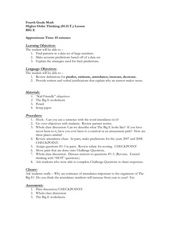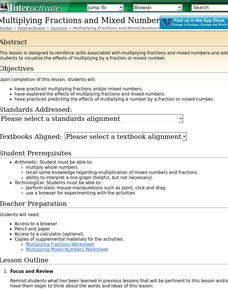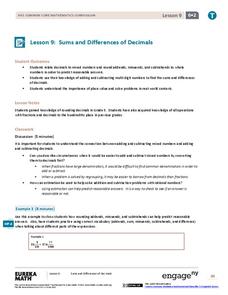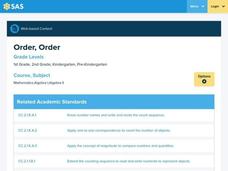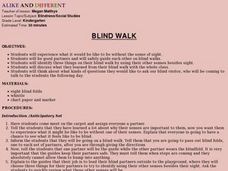Curated OER
Higher Order Thinking (H.O.T.) Lesson - BIG E
Fourth graders work with patterns while using large numbers. In this patterning lesson, 4th graders go over the definitions of the words: predict, estimate, attendance, increase, and decrease. They complete worksheets in which they track...
Curated OER
Multiplying Decimals and Mixed Numbers
Students practice multiplying decimals and/or mixed numbers, explore the effects of multiplying decimals and mixed numbers, and practice predicting the effects of multiplying a number by a decimal or mixed number.
Curated OER
Multiplying by Two-Digit Numbers
In this mathematics worksheet, 6th graders find the product of a given equation. Then they use an array and find the sum of the partial products. Students also use zeros as place holders when necessary.
Curated OER
Lesson 3: Number Sense
Learners solve word problems using number sense. They convert fractions to decimals and mixed numbers. Pupils determine if a given fraction is greater or less than another fraction, and order numbers on a number line.
Curated OER
Guesstimate? NO Estimate!
Students discover the advantage of estimation over simple guessing using number relationships. They also discover how useful a mathematical tool estimation is in everyday life.
Curated OER
Subtraction with Regrouping Lesson Plan
Learners explore regrouping while subtracting. In this subtraction lesson, pupils manipulate base 10 blocks to demonstrate regrouping. Multiple resources are provided.
Curated OER
Rational, Irrational and Square Roots
Students identify rational and irrational numbers and their use in mathematical functions. Through demonstration, students discover the difference between rational and irrational numbers and their use. Using estimation skills students...
Illustrative Mathematics
Cynthia's Perfect Punch
Using a real-world example, this problem illustrates the thought process that learners need to engage in to understand adding mixed numbers with common denominators. First by looking at estimation, and then by drawing models that...
Curated OER
Rounding
First graders round to estimate greater sums. After a lecture/demo, 1st graders complete a web instructional activity on estimation. They practice rounding to the nearest hundred using a restaurant take-out menu.
University of Waterloo
Rounding and Estimating 1: Introduction
Pupils practice mental math skills in math drills. They play the online interactive game "Rounding Off" to practice rounding off different numbers. Afterward, they complete a paper based follow up exercise for reinforcement.
Curated OER
Third Grade Math
In this math worksheet, 3rd graders complete multiple choice questions about fractions, evens and odds, decimals, and more. Students complete 20 questions.
EngageNY
Why Worry About Sampling Variability?
Are the means the same or not? Groups create samples from a bag of numbers and calculate the sample means. Using the sample means as an estimate for the population mean, scholars try to determine whether the difference is real or not.
EngageNY
Sums and Differences of Decimals
Sometimes dealing with decimals is so much easier than dealing with fractions. The ninth lesson in a 21-part module has the class consider situations when it might be easier to add or subtract fractions by first converting to decimals....
Pennsylvania Department of Education
Order, Order
Students use pictures to identify items as ordinal numbers. In this ordinal numbers lesson plan, students use the words "before" and "after" to identify the pictures as well.
Curated OER
Multiplication Lesson Plan
Young scholars roll dice to come up with 1 digit numbers that they multiply together. In this multiplication lesson plan, students arrange piles of blocks and count them to complete problems.
Curated OER
Shel Silverstein Poetry Math
Fifth graders explore the connection between poetry and math by reading poems that involve numbers. For this Shel Silverstein poetry math lesson, 5th graders listen to 5 poems read aloud and discuss how math was used in the poems. ...
Curated OER
Blind Walk
Students experience what it would be like to live without the sense of sight, identify three things on a blind walk by using senses other than sight, and discuss what they learned from the experience with the whole class.
Curated OER
Slicing Up Fractions
Add and multiply fractions with your elementary and middle schoolers! They review the concepts of equivalent fractions, adding fractions, and multiplying fractions as they solve problems involving pieces a virtual pizza. Lots of practice...
Curated OER
Making Estimations in Measurement
Students utilize their knowledge of measurement in making accurate measurements and estimations.
EngageNY
Estimating Digits in a Quotient
Boiling down any division problem to a one-digit divisor problem sure makes estimation easy. The lesson shows how to estimate division problems by using place value understanding and basic arithmetic facts to simplify the division. Some...
EngageNY
The Pythagorean Theorem
Class members explore the estimation of irrational numbers in association with the Pythagorean Theorem. The first lesson of this module challenges pupils to use the Pythagorean Theorem to find unknown side lengths. When the length is not...
Curated OER
Beanie Baby Bonanza
Third graders add and subtract decimals. In this third grade mathematics instructional activity, 3rd graders are given an imaginary $100 to purchase five Beanie Babies. Students determine which five they would like to purchase and...
Curated OER
Deric's Blotto
Students solve the handshake problem and investigate triangular numbers. In this geometry lesson, students investigate Blotto games as they apply concepts of triangles and geometric theorems.
Curated OER
BASE-ic Space Travel
In this 3-day place-value lesson, upper-elementary kids investigate the base 5 and base 2 systems as an introduction to exponents and powers. They create a pocket chart to help ground their understanding of bases, exponents, and powers,...


